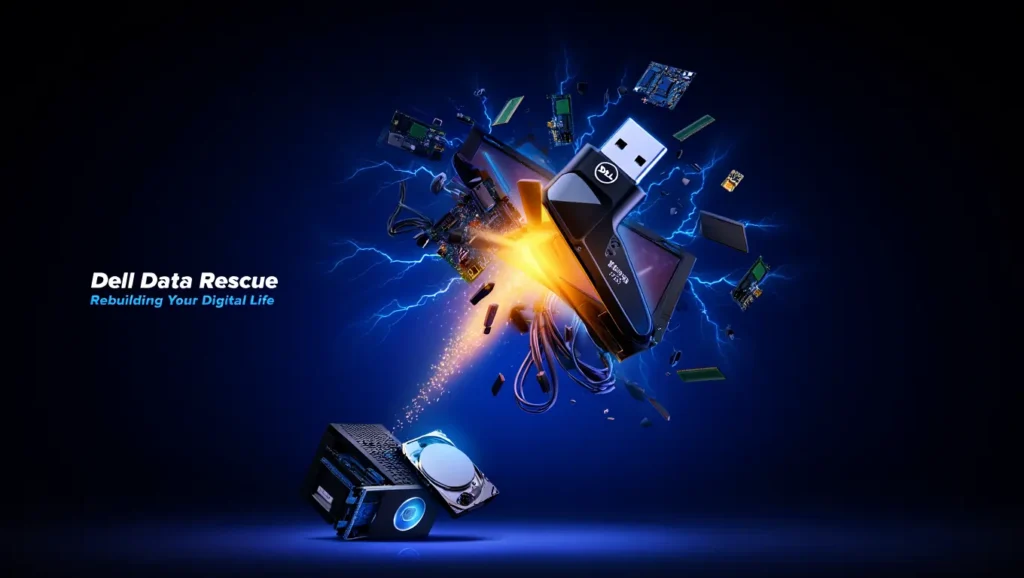Introduction
The Dell USB Recovery Tool is software specially made by Dell for Dell devices. Its main job is to reinstall or restore the Windows operating system. The main purpose is that if your laptop is not booting properly or Windows has become corrupted, you can use this software to create a bootable USB drive. Then this USB helps start your system and restore it to factory settings.
In simple words, this is a backup & recovery software designed especially for Dell devices.
Requirements to Create a Dell USB Recovery Software
If you want to create a recovery software, below are the points that show what instruments are required:
1. Minimum Hardware Range
- You should have at least one empty drive with 16 GB of space.
- RAM & storage space in your laptop/PC must be enough to store the image and run the tool easily.
- A charged laptop is important, so the system doesn’t turn off during the process.
2. Account & Data
- Dell Microsoft Account (sometimes a login is required).
- Back up your important data, because during the recovery process, data can be erased.
3. Network & Storage
- Internet connection must be stable because Windows images need to be downloaded.
- System drive (C:) must have enough space to store temporary files.
Downloading the Dell Tool
1. Where to Download
You should download only from Dell’s official support website (avoid third-party sites).
2. Choose System Architecture
Check your PC or laptop’s Windows version (32-bit or 64-bit) and select the correct software.
3. Verify the Download
After downloading, check the setup file to make sure it’s working properly — I mean, it’s not corrupted or having any issues.
Creating the Recovery USB
Here, I’ll explain step by step how you can run the tool and prepare your USB after downloading:
1. Insert the USB
Insert at least a 16GB USB drive into the system (make sure it is empty, because the process erases all data).
2. Open Dell USB Recovery Tool
Run the software you downloaded and enter your Dell account / Service Tag.
3. Download Recovery Image
The tool automatically downloads the correct Windows image (ISO) for your system model.
4. Select the USB Drive
Choose the connected USB drive and confirm.
5. Make Bootable USB
The software formats the USB and copies recovery files to make it bootable recovery media.
6. Process Complete
After the process completes, you will have a ready Dell USB Recovery Software that you can use for your laptop.
Booting From Recovery USB
Please follow these steps:
- Insert the USB recovery drive into the system.
- Restart your laptop/PC.
- Open the Boot Menu (F12 / Esc / F2 depending on the model).
- From the boot device list, select the USB drive.
- The system will boot from the USB, and the Dell recovery environment will load.
Reinstalling Windows Options
In this section, you will have some choices to select from:
- Keep My Files → Only Windows resets, your personnel files stay safe.
- Remove Everything → Clean installation of the system (all files are deleted).
- Factory Image Restore → System resets exactly as it was when new (with Dell drivers & apps).
Troubleshooting Common Errors
Some common issues in Recovery Software and their fixes:
- USB not detected → Format USB or try another port.
- Recovery image download fails → Use stable internet/retry.
- USB not showing in Boot Menu → Check BIOS settings (Enable Legacy/UEFI).
- “Not enough space” error → Use a larger USB (more than 16GB).
Alternatives & Backup Options
If your Dell USB Recovery Software is not working, you can try these:
- Create a Windows built-in recovery drive.
- Use Cloud Recovery (download directly from the Dell support website).
- Use third-party backup software.
- Manually create a System Image Backup on Windows.
Conclusion
The Dell USB Recovery Tool is a simple and effective way to fix your Dell laptop or PC. If your Windows ever faces an issue, having this Dell USB Recovery Software will give you the solution—you won’t need to go out or call an engineer. I’ve shared the complete details on how to create it and how to start it. Just try it and follow the steps I’ve explained.

2 Comments
Pingback: How to Read Articles Behind a Paywall Legally and Ethically
Pingback: AI Nudifier: What It Is, Why It’s Harmful, and How to Fight Back